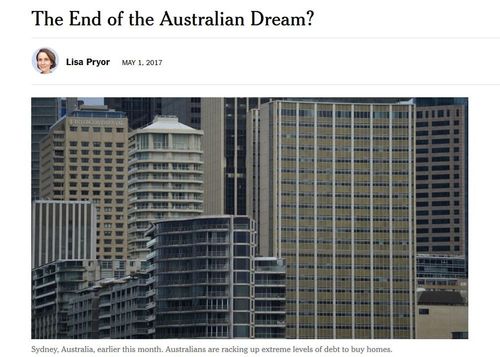From the NYT Op-Ed page:
The End of the Australian Dream?Of course, that was during the Completely Evil “White Australia” days. Wait a minute … do you think there might have been a connection between Australian egalitarianism and Australian anti-immigrationism?Lisa Pryor MAY 1, 2017
SYDNEY, Australia — … In the past 20 years, Australia has become a nation where getting ahead is a national obsession, partly because we have come to expect a world where the natural course of events is to become a little bit richer each year. The winnings of our repeated economic booms have been squandered on inflationary policies that fuel the rat race.
What we are discovering is that when you have a nation full of people trying to get to the top, eventually most of the population is forced to run just to keep up. Our enviable quality of life is at risk.
Consider what has happened with the housing market, Australia being a country where real estate is not just a place to live but a ticket to prosperity and a statement of taste and values.
Generous tax breaks for homeowners and real estate investors have fueled the market to the point where the median price of a house in Sydney, our largest metropolis, is $1.1 million Australian dollars, or about $824,000.
An entire genre of newspaper writing is dedicated to telling Australians what they could buy for the same money in other parts of the world — a small chateau in the South of France, even an apartment in Manhattan, for the price of an ugly brick house 40 minutes’ drive from the center of the city. We watch shows like “Million Dollar Listing Los Angeles” and laugh.
… Australia has some of the highest household debt in the world, especially if you compare our debt to our incomes and G.D.P. We are poised for disaster if there is a serious economic downturn.
Even for those lucky enough to own their own home, there is a fool’s-gold feel to this property boom. After all, if you own a three-bedroom house five miles from the city and it increases in value by 50 percent, that means you still have only enough money to buy a three-bedroom house five miles from the city. This is not so much rising wealth as glorified inflation.
And for those who are not owners? The property boom is dividing the nation along lines of age and class. For young people, property prices represent dashed hopes and a looming intergenerational battle.
… Many middle-class parents have become anxious about sending children to the local public high school out of fear that they will lag behind their peers at schools that are expensive or academically selective.
We need to rediscover our egalitarian roots. It is true that Australian culture can be anti-intellectual. We can deride achievement and cut down those who succeed, in a phenomenon we call tall poppy syndrome. But the egalitarian values of our society should not be discounted. In fact, it is on the matter of egalitarianism that Australia has made some of its most important intellectual contributions to the world.
Australia was one of the first countries to institute a living minimum wage, in a famous court case back in 1907 regarding the employees of the Sunshine Harvester Works. The court decided that an unskilled worker should be paid enough to meet the needs of “a human being living in a civilized community,” which included keeping his family in “frugal comfort.” …
… Nah!
You see, one thing is Good and the other thing is Bad.
We need to remember what makes Australia a fairy tale and protect it.Of course, the text string “migra” doesn’t appear anywhere in this piece.
Australia has a policy against low-skilled immigration, so it still has a more prosperous native blue collar class than the U.S., but it encourages high skill immigration. This is less self-destructive than the U.S. policy, but it has obvious effects like squeezing younger natives out of the home-buying class.













